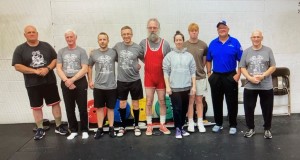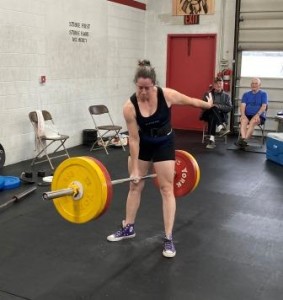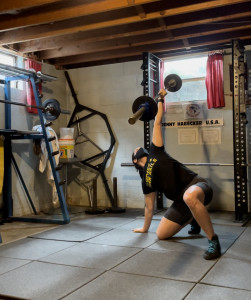World Championships
By Al Myers
2022 IAWA WORLD CHAMPIONSHIPS
Once again Denny and Judy Habecker hosted a great World Championships in their hometown of Lebanon, PA. I believe this marks the SIXTH time the Habeckers have promoted Worlds – making them the ALL TIME leaders putting on the IAWA World Championships.
Like last year, the number of competitors were down in numbers. I’m hoping this is still due to post COVID reasons, but it’s a little concerning. However, the lifting was superb and the meet was an overall success. We dedicated this World Championships to Karen Gardner as she’s fighting health issues right now and could not attend. Steve and Karen have always been a perennial presence at this meet, and I have to admit it seemed a little “off” not sharing the announcing table with Steve.
Beth Skwarecki from Pittsburgh was the lone women’s competitor but she represented well!! Her performance was worthy of being a champion. She impressed me with several of her lifts and her technique is flawless.
Three lifters from England made the trip to the states to compete. Steve Sherwood won the OVERALL BEST LIFTER title and AGAIN showed us that he is still the best in our sport. I always enjoy watching Steve lift. He’s a perfectionist with his lifting and a true gentleman off the platform.
Paul Barette and Danny Kingsland from the Metamorfit Gym in Eastbourne both had great meets. This was the first time that Danny has traveled to the states to lift. I want to REALLY thank Steve, Paul, and Danny for attending.
Young Aidan Habecker was the youngest lifter at 19, and his “gramps” Denny the oldest at 80. However, Aidan is not the kid lifter he used to be as he’s a young man now, and he posted the highest total of the meet at 630 kilograms. He was the last lifter on the platform when the meet was over as he nailed a 170 kg VB deadlift for record, which was a fitting way to end the meet.
I want to mention Frank Ciavattone. Frank has dealt with ALOT lately but still competed and posted a mark in all the lifts. Even though his One Hand Deadlift was a token lift for him at this meet, it still impressed me just getting to watch the legend in action with his signature lift.
Randy Smith made the road trip from Michigan to compete. Randy was last year’s overall best lifter at Worlds but ended up second overall to Steve this year. Outside of a few more grey hairs Randy still looks and lifts like he did 20 years ago.
Again, I want to thank Denny and Judy for all they did to make this another great championships for IAWA.
Meet Results:
2022 World IAWA World Championships
October 1st & 2nd, 2022
Lebanon, PA
Meet Director: Denny Habecker
Meet Announcer/Scorekeeper: Al Myers
Meet Officials (3-official system used): Denny Habecker, Barry Pensyl, Beth Skwarecki, Steve Sherwood, Paul Barette, Frank Ciavattone, Randy Smith
Meet Loaders: All Lifters
Meet Lifts: DAY 1 Clean and Press, Continental Snatch, Cheat Curl, One Hand Deadlift DAY 2 Continental Clean and Jerk, Pullover and Push, 2 2″ Vertical Bar Deadlift
WOMENS DIVISION
| Lifter | Age | BWT | C&P | Sna | Curl | 1HDL | C&J | P&P | VB | TOT | PTS |
| Beth Skwarecki | 41 | 67.5 | 40 | 55 | 52.5 | 95R | 70 | 85 | 96 | 492.5 | 537.8 |
EXTRA ATTEMPTS FOR RECORD
Beth S Cheat Curl 56K
One Hand DL Right 101K
MENS DIVISION
| Lifter | Age | BWT | C&P | Sna | Curl | 1HDL | C&J | P&P | VB | TOT | PTS |
| Steve Sherwood | 71 | 80.5 | 45 | 55.5 | 68 | 150L | 55 | 75 | 140 | 588.5 | 777.7 |
| Randy Smith | 68 | 87.0 | 55 | 50 | 67.5 | 122.5R | 67.5 | 92.5 | 140 | 595.0 | 718.6 |
| Denny Habecker | 80 | 83.1 | 42.5 | 35 | 42.5 | 92.5R | 45 | 72.5 | 87.5 | 417.5 | 612.0 |
| Aidan Habecker | 19 | 83.0 | 50 | 60 | 67.5 | 125R | 70 | 92.5 | 165 | 630.0 | 604.3 |
| Paul Barette | 46 | 74.8 | 50 | 52.5 | 65 | 120L | 62.5 | 82.5 | 95 | 527.5 | 565.4 |
| Danny Kingsland | 32 | 64.8 | 65 | 45 | 60 | 0 | 60 | 97.5 | 105 | 432.5 | 476.0 |
| Frank Ciavattone | 67 | 130.0 | 20 | 20 | 40 | 90R | 20 | 50 | 105 | 345.0 | 332.7 |
| Al Myers | 56 | 104.8 | — | — | — | — | — | — | 105 | 105.0 | 101.5 |
Notes: Steve Sherwood weighed in on Day 2 at 79.9 (80KG Class). All other lifters weighed in at the same class as Day 1.
EXTRA ATTEMPTS FOR RECORD
Aidan Habecker Cheat Curl 68.5K
Aidan Habecker 2×2″ VB 170K
Notes: All lifts recorded in kilograms. BWT is bodyweight recorded in kilograms. R and L designate right and left. TOT is total kilograms lifted. PTS are overall points adjusted for bodyweight and age corrections.
BEST LIFTER AWARDS
Womens Master 40-44: Beth Skwarecki
Womens Overall: Beth Skwarecki
Mens Junior: Aidan Habecker
Mens Senior: Danny Kingsland
Mens Master 45-49: Paul Barette
Mens Master 55-59: Al Myers
Mens Master 65-69: Randy Smith
Mens Master 70-74: Steve Sherwood
Mens Master 80-84: Denny Habecker
Mens Overall: Steve Sherwood



